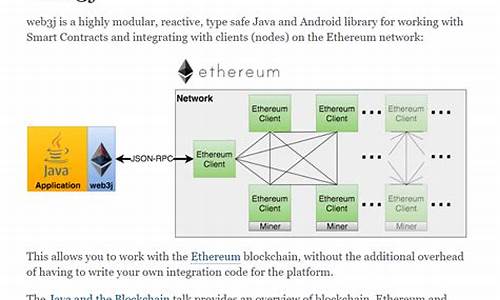
随着区块链技术的发展,越来越多的人开始关注数字货币和以太坊。而以太坊钱包作为存储和管理以太币的重要工具,也逐渐受到了广泛关注。今天,我们将介绍如何使用web3j构建一个以太钱包。
我们需要了解什么是web3j。Web3j是一个用于与以太坊节点进行交互的Java库,它提供了一组API,可以让我们方便地与以太坊网络进行通信。通过使用web3j,我们可以在Java程序中实现对以太坊的各种操作,例如创建账户、发送交易、查询余额等。
接下来,我们将详细介绍如何使用web3j构建一个简单的以太钱包。我们需要导入web3j库:
```java
import org.web3j.protocol.Web3j;
import org.web3j.protocol.core.methods.response.EthAccounts;
import org.web3j.protocol.http.HttpService;
```
我们需要创建一个Web3j实例,并连接到以太坊节点:
```java
String url = "https://mainnet.infura.io/v3/YOUR-PROJECT-ID"; // 替换为你的项目ID
Web3j web3j = Web3j.build(new HttpService(url));
```
在成功连接到以太坊节点后,我们可以使用以下代码获取当前用户的以太坊地址:
```java
EthAccounts accounts = web3j.ethGetAccounts().send();
String address = accounts.getAccounts().get(0);
System.out.println("Your Ethereum address is: " + address);
```
至此,我们已经成功获取到了当前用户的以太坊地址。接下来,我们可以编写一个简单的函数来发送以太币:
```java
public void sendEther(String toAddress, BigDecimal amount) {
String privateKey = "YOUR-PRIVATE-KEY"; // 替换为你的私钥
String fromAddress = accountAddress; // 从上一步获取的地址中选择一个作为发送方地址
BigInteger nonce = web3j.ethGetTransactionCount(fromAddress, DefaultBlockParameterName.LATEST).send().getTransactionCount();
BigInteger gasPrice = web3j.ethGasPrice().send().getGasPrice();
BigInteger gasLimit = web3j.ethGasLimit().send().getGasLimit();
TransactionReceipt receipt = web3j.ethSendRawTransaction(privateKey, toAddress, amount.toPlainString(), nonce, gasPrice, gasLimit).send().getTransactionReceipt();
System.out.println("Transaction receipt: " + receipt);
}
```
我们可以在主函数中调用这个函数来发送一些以太币:
```java
public static void main(String[] args) {
String toAddress = "RECIPIENT-ADDRESS"; // 替换为接收方的地址
BigDecimal amount = new BigDecimal("0.1"); // 要发送的以太币数量,单位为wei(1e-18)
new Wallet().sendEther(toAddress, amount);
}
```
以上就是如何使用web3j构建一个简单的以太钱包的方法。通过这个示例,你可以学习到如何使用Java与以太坊网络进行交互,实现基本的加密货币操作。当然,这只是一个简单的示例,实际应用中可能需要考虑更多的安全和功能性问题。希望这篇文章能帮助你入门以太坊钱包开发。





